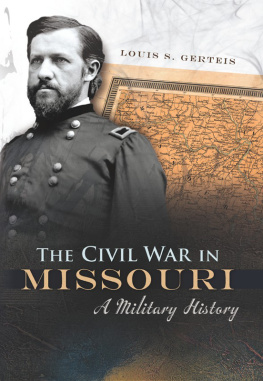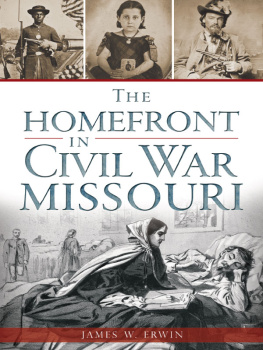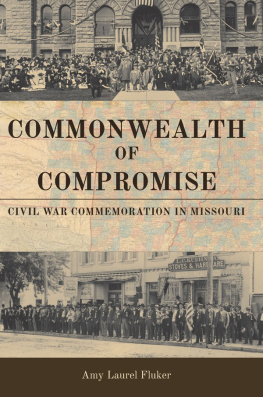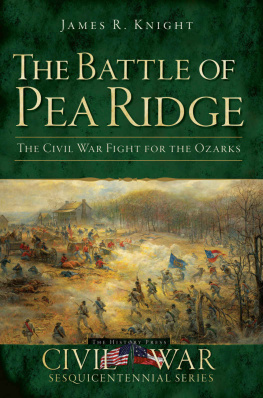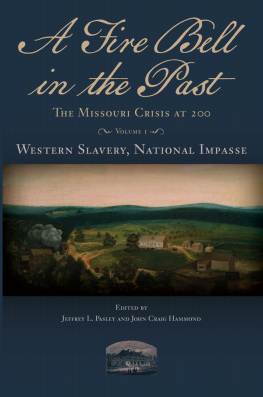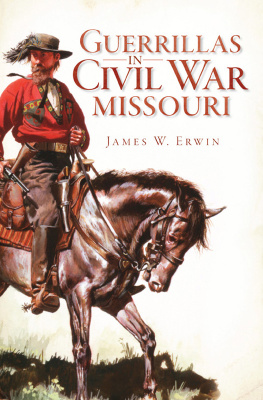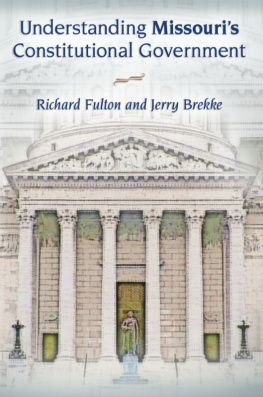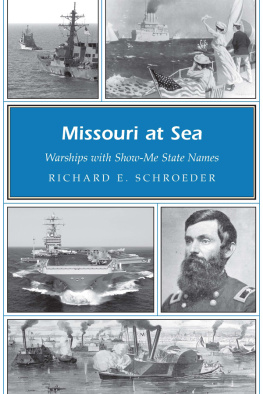MISSOURIS WAR
THE CIVIL WAR IN THE GREAT INTERIOR
Series Editors
Martin J. Hershock and Christine Dee
Ohios War: The Civil War in Documents, edited by Christine Dee
Missouris War: The Civil War in Documents, edited by Silvana R. Siddali
Indianas War: The Civil War in Documents, edited by Richard F. Nation and Stephen E. Towne
FORTHCOMING:
Kansass War: The Civil War in Documents, edited by Pearl T. Ponce
Michigans War: The Civil War in Documents, edited by John W. Quist
Wisconsins War: The Civil War in Documents, edited by Chandra Manning
MISSOURIS WAR
The Civil war in Documents
EDITED BY SILVANA R. SIDDALI
Ohio University Press
Athens
Ohio University Press, Athens, Ohio 45701
www.ohioswallow.com
2009 by Ohio University Press
All rights reserved
To obtain permission to quote, reprint, or otherwise reproduce or distribute material from Ohio University Press publications, please contact our rights and permissions department at (740) 593-1154 or (740) 593-4536 (fax).
Printed in the United States of America
Ohio University Press books are printed on acid-free paper

16 15 14 13 12 11 10 09 5 4 3 2 1
Cover art: Order No. 11, by George Caleb Bingham. Courtesy Cincinnati Art Museum, The Edwin and Virdinia Irwin Memorial
Library of Congress Cataloging-in-Publication Data
Missouris war : the Civil War in documents / edited by Silvana R. Siddali.
p. cm.(The Civil War in the great interior)
Includes bibliographical references and index.
ISBN 978-0-8214-1732-4 (pbk. : alk. paper)
1. MissouriHistoryCivil War, 18611865Sources. 2. MissouriHistoryCivil War, 18611865Social aspectsSources. 3. MissouriPolitics and government18611865Sources. 4. SlaveryMissouriHistory19th centurySources. 5. SlaveryPolitical aspectsMissouriHistory19th centurySources. 6. African AmericansMissouriHistory19th centurySources. 7. African AmericansMissouriSocial conditions19th centurySources. I. Siddali, Silvana R.
E517.M576 2009
977.803dc22
2009024626
Dedicated to my brothers, Wolff, Raphael, and Steve.Contents
Series Editors Preface
The Civil War in the Great Interior series focuses on the Middle West, as the complex region has come to be known, during the most critical era of American history In his Annual Message to Congress in December of 1862, Abraham Lincoln identified the great interior region as the area between the Alleghenies and the Rocky Mountains, south of Canada and north of the culture of cotton. Lincoln included in this region the states of Ohio, Indiana, Michigan, Wisconsin, Illinois, Missouri, Kansas, Iowa, Minnesota, and Kentucky; the area that would become West Virginia; and parts of Tennessee and the Dakota, Nebraska, and Colorado territories. This area, Lincoln maintained, was critical to the great body of the republic not only because it bound together the North, South, and West but also because its people would not assent to the division of the Union.
This series examines what was, to Lincoln and other Americans in the mid-nineteenth century, the most powerful, influential, and critical area of the country. It considers how the people of the Middle West experienced the Civil War and the role they played in preserving and redefining the nation. These collections of historical sourcesmany of which have never been publishedexplore significant issues raised by the sectional conflict, the Civil War, and Reconstruction. The series underscores what was unique to particular states and their residents while recognizing the values and experiences that individuals in the Middle West shared with other Northerners and, in some cases, with Southerners.
Within these volumes are the voices of a diverse cross-section of nineteenth-century Americans. These include African Americans, European immigrants, Native Americans, and women. Editors have gathered evidence from farms and factories, rural and urban areas, and communities throughout each state to examine the relationships of individuals, their communities, the political culture, and events on the battlefields. The volumes present readers with layers of evidence that can be combined in a multitude of patterns to yield new conclusions and raise questions about prevailing interpretations of the past.
The editor of each volume provides a narrative framework through brief chapter introductions and background information for each document, as well as a timeline. As these volumes cannot address all aspects of the Civil War experience for each state, they include selected bibliographies to guide readers in further research. Documents were chosen for what they reveal about the past, but each also speaks to the subjective nature of history and the decisions that historians face when weighing the merits and limits of each piece of evidence they uncover. The diverse documents included in these volumes also expose readers to the craft of history and to the variety of source materials historians utilize as they explore the past.
Much of the material in these works will raise questions, spark debates, and generate discussion. Whether read with an eye toward the history of the Union war effort, a particular state or region, or the Civil Wars implications for race, class, and gender in America, the volumes in The Civil War in the Great Interior help us considerand reconsiderthe evidence from the past.
Martin J. Hershock
Christine Dee
Preface
As early as November 1861, the Missouri Republican published reports of blasted farms, gangs of horse thieves, and a war amongst neighbors and brothers. More than any other border state, Missouri suffered criss-crossing raids by guerrilla fighters, invasions by soldiers of both armies, and bitter internal violence. Indeed, for many Missourians, civil warfare began years before the battle of Fort Sumter. Through primary source documents, Missouris War seeks to capture the experience of the people who lived through the war: soldiers and their families; slaves and their owners; politicians, newspaper editors, and businessmen. Although the reader will find some familiar texts, such as General John C. Frmonts famous proclamation of martial law and Dred Scotts petition for freedom, many of the documents have never been published before: letters, diary entries, newspaper editorials, official correspondence, songs, and pamphlets.
The book begins with Missourians early commitment to slavery and the conflicts with antislavery forces in neighboring Kansas. These divisions provide the context for the continuing struggles in the state throughout the Civil War and Reconstruction. Chapter 1 reveals the lives of people in bondage and the important role they played in Missouris economy. Their daily existence was hard, and many of them suffered terrible losses as family members were sold away. Most Missourians, however, adamantly maintained that slavery was a permanent part of the states way of life and that the U.S. Constitution protected their right to own slaves. The settlers commitment to the institution of slavery led to terrible conflicts across the border in the Kansas Territoryconflicts that continued to plague Missourians throughout the Civil War. The antislavery settlers in Kansas, most of whom had come from New England, clashed violently with the pro-Southern Missouri farmers, who feared that a free Kansas would lure their slaves to escape.


